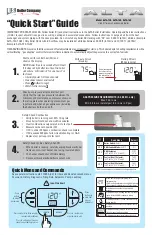
Gas Fired Boiler
Harsco Industrial, Patterson-Kelley Technical Service 1.877.728.5351
27
4. Place the appliance being inspected in operation. Follow the lighting
instructions. Adjust the thermostat so that the appliance will operate
continuously.
5. Test for spillage at the draft hood relief opening after 5 minutes of main
burner operation. Use the flame of a match or candle or smoke from a
cigarette, cigar or pipe.
6. After it has been determined that each appliance remaining
connected to the common venting system properly vents when tested
as outlined above, return doors, windows, exhaust fans, fireplace
dampers and any other gas-burning appliance to their previous
conditions of use.
Any improper operation of the common venting system should be
corrected so the installation conforms to the National Fuel Gas
Code,
ANSI Z223.1
and
CSA B149
Installation Code. When resizing
any portion of the common venting system, the common vent
system should be resized to approach the minimum size as
determined using the appropriate tables in part 11 of the National
Fuel Gas Code,
ANSI Z223.1
/
NFPA 54
and/or
CAN/CSA B149.1
Natural Gas and Propane Installation Code.
3.6 Gas Piping
Before making the gas hook-up, make sure the boiler is being
supplied
with the type of fuel shown on the boiler nameplate.
The boiler shall be installed such that the gas ignition
system components are protected from water (dripping,
spraying, rain, etc.) during appliance operation and
service (circulator replacement, control adjustment, etc.)
The boiler is factory fire-tested and adjusted for proper
combustion. The gas train components are certified to
handle a maximum inlet pressure of
14" w.c. (1/2 psig).
Typical gas pressure supply for natural gas is 7" w.c. (11"
w.c. for propane). If the available gas pressure exceeds
14" w.c., a suitable additional intermediate gas pressure
regulator of the "lock up" type must be provided to reduce
the pressure to less than 14" w.c. Refer to boiler label
for minimum inlet gas pressure.
Install a sediment trap (drip leg) and a union connection ahead of the primary manual shutoff valve on the boiler.
A gas piping schematic is shown above. Gas piping should be installed in accordance with National Fuel Gas
Code,
ANSI Z223.1
, latest edition, and any other local codes which may apply; in Canada see
CAN/CSA-B.149.1
,
latest edition. In the Commonwealth of Massachusetts, the gas cock must be a “T-handle type.”
Table 3.6:
Pipe Capacity for Natural Gas
Nominal
Iron Pipe
Size
(Inches)
Internal
Diameter
(Inches)
Equivalent Pipe
Length
Maximum Capacity in Cubic Feet of Natural Gas Per Hour Pressure
Drop of 0.5 inch Water Column/Equivalent Length of Pipe (in feet)
90o Ell
(Feet)
Tee
(Feet)
20
40
60
80
100
150
200
2
2.067
5.17
10.3
2750
-
-
-
-
-
-
2.5
2.469
6.16
12.3
4350
3000
2400
-
-
-
-
3
3.068
7.67
15.3
7700
5300
4300
3700
-
-
-
4
4.026
10.1
20.2
15800
10900
8800
7500
6700
5500
4600
All threaded connections must be
made using a pipe compound that
is resistant to the action of liquefied
petroleum gases. Do not use
Teflon tape on gas line threads!
N
OTICE
!
See Pipe Capacity for Natural Gas
chart on the following page for
required pipe size, based on
overall length of pipe from the
meter plus equivalent length of all
fittings. Approximate sizing may
be based on 1 cubic foot of natural
gas per 1,000 Btu per hour input,
i.e., 3,000,000 Btu/hr requires
about 3,000 cubic feet per hour.
(See “Typical Boiler Operating
Conditions,”
Section 4.4
for more
information.)
Figure 3.6:
Simplified Gas Piping
Summary of Contents for SC-2000
Page 50: ...Gas Fired Boiler Harsco Industrial Patterson Kelley Technical Service 1 877 728 5351 50...
Page 52: ...Gas Fired Boiler Harsco Industrial Patterson Kelley Technical Service 1 877 728 5351 52...
Page 54: ...Gas Fired Boiler Harsco Industrial Patterson Kelley Technical Service 1 877 728 5351 54...
















































